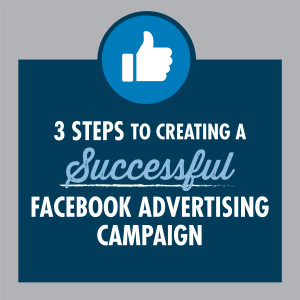
There is no denying that Facebook has revolutionized the online world. It is estimated that 2 billion people are active on this free social site. That’s nearly 30% of the world’s population! Moreover, Facebook purchased the social media site Instagram in 2012, which has currently grown to approximately 800 million active users. With access to both sites, there’s no wonder why companies are flocking to Facebook to tap into the billions of potential consumers on both social platforms. However, even with user-friendly planning tools (the recent consolidation of Ads Manager & Power Editor has helped), advertising on Facebook can seem daunting. Below are three steps you should consider for a successful Facebook advertising campaign.
Know your Goal
Just like with any other advertising campaign, it is important to set a goal before you begin. Facebook offers 10 campaign objectives to choose from. Options include driving traffic to your website, garnering more followers, creating a list of leads and more. Once you set your goal, Facebook will then give you a range of ad formats that will help you achieve that goal.
We recommend that businesses select one goal and stick with it for the entirety of the ad campaign. You will receive more specific feedback and statistics from Facebook after the campaign, allowing you to improve your advertising for the future and receive a higher ROI. If you choose to have multiple goals within the same campaign, make sure that the utilize ads coincide with the various goals.
Know your Audience
In order to maximize your ad dollars it’s important to go into your Facebook campaign knowing your target audience. Facebook Ads Manager allows you to be extremely specific with the type of consumer that will be exposed to your ads. The social platform has partnerships with data brokers that allow you to refine your audience based on location, gender, and even online behaviors. For those with an established consumer base, Facebook can also create a lookalike audience, taking the characteristics of your current audience and finding additional consumers that fit that profile.
The targeting options are available for both Instagram and Facebook. We recommend allowing Facebook to include both platforms in the campaign. Facebook has a larger number of total users, but tends to skew older, with adults ages 45-54 spending more time on Facebook then any other group. However, 59% of Instagram users are between the ages of 18-29. While it’s easy to spend ad dollars on Facebook because of the higher number of active users, there are benefits to advertising on both platforms. The new Ads Manager platform has helped streamline the planning and management of advertising on both Facebook and Instagram.
Know your Budget
Advertising on Facebook can become very costly, very quickly. That’s why it’s important to understand the budgeting tools available and the differences between each budget setting. Facebook allows you to budget your advertising dollars across multiple campaigns. This can be done through either a Daily or Lifetime Budget. When you select Daily Budget for your campaign, you’re telling Facebook how much money to spend each day. The Lifetime Budget indicates how much you want to spend over the course of the entire advertising campaign.
So if you want to spend $100 over the course of 10 days why does it matter which one you choose? The answer lies with how Facebook spends your ad dollars. When you choose Daily Budget, you’re telling the site to spend all of the allotted money in one day. In order to spend the entire amount each day, they may place ads in areas or times that are less ideal.
When you choose the Lifetime Budget model, Facebook may deploy your ad at the most optimal time, allowing you to receive more return on your ad purchase. It’s important to note that once you select a budget option you are not allowed to change it. However, you can duplicate the campaign and switch the budgeting type at that point.
Facebook advertising has done a great job of streamlining the advertising process for companies of all sizes, but it is important to take a strategic approach before starting in order to ensure you receive the best return on your investment.



